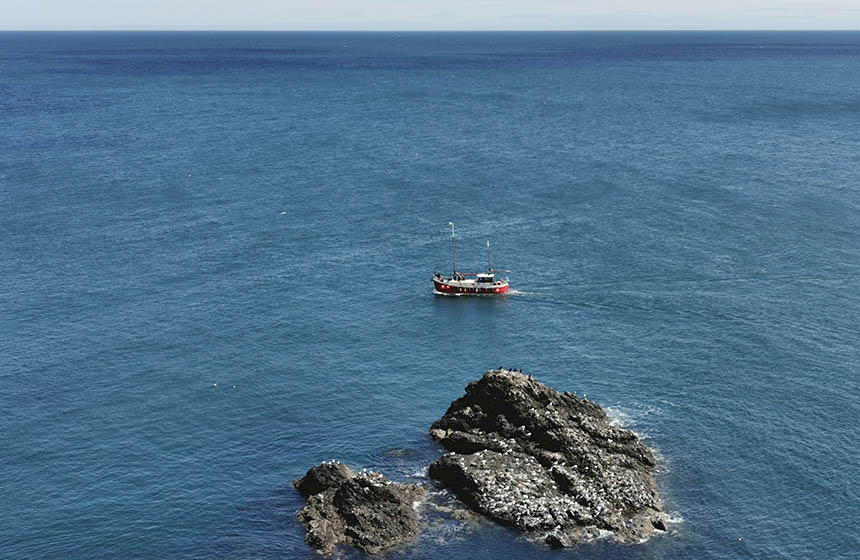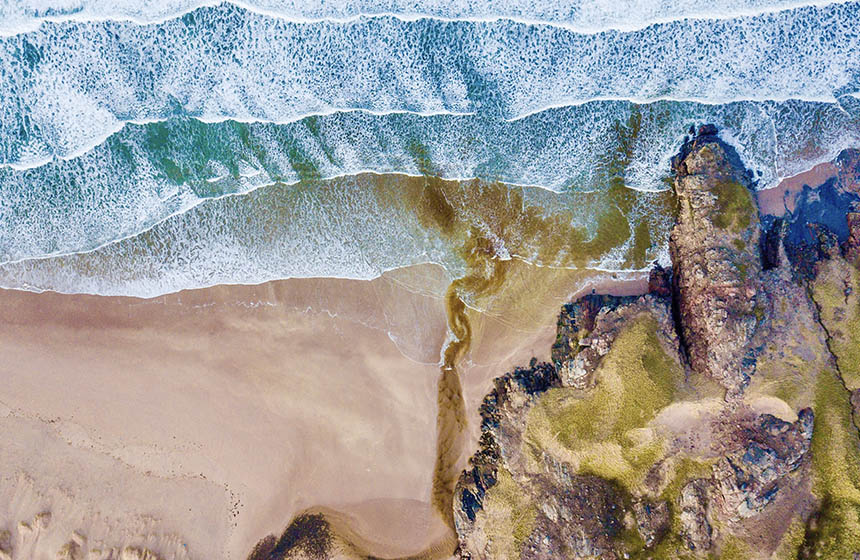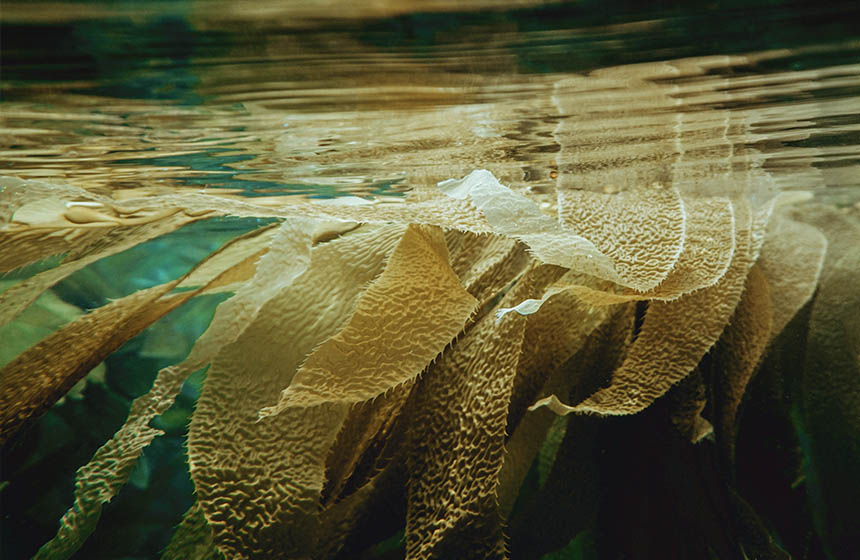Lamlash Bay No-Take Zone
The Lamlash Bay No-Take Zone was established due to 13 years of community campaigns, and aims to protect maerl beds, seagrass beds, and kelp forest ecosystems through fishing or extraction bans.
Nature-based intervention:
Fish stocks in the Clyde Sea collapsed following the repeal of a trawling ban in 1962 (1) (2). Yet the continued presence of juvenile fish and their habitats, and a large and healthy population of the Norway lobster, indicated that recovery could be possible if a ban on trawling and dredging was reinstated (3) (4).
In 2008, following a long campaign by the Community of Arran Seabed Trust (COAST), a 2.67 km2 No-Take Zone was established in Lamlash Bay where no fishing or extraction is permitted from the water, seabed, or shore. Lamlash Bay was chosen because it hosts large beds of maerl (an unattached calcareous red alga), seagrass beds, kelp forests, and boulders that provide habitat for sea life (5). In addition, the boundaries of the zone provide a clear entrance from the southern and northern side of the bay, making it easy to view, monitor and police fishing boats that enter the area from the shore (6). In 2016, a wider 282 km2 area encapsulating the No-Take Zone was established as the South Arran Marine Protected Area, resulting in the exclusion of scallop dredging and limitations on prawn trawling activity, although more sustainable forms of fishing were allowed to continue (7). Overall, the work of COAST and the Lamlash Bay project resulted in the recovery of damaged seabed and was instrumental in paving the way for national and international marine protection (8).
Overview of context:
Motivated by the demise of demersal fish landings in the Clyde due to bottom trawling and the lack of response from the Scottish Government, two Arran divers set up COAST in 1995 to protect marine habitats in Arran’s seas. Inspired by marine reserves in New Zealand and their benefits to fisheries and the marine environment, COAST campaigned for 13 years for the government to establish a No-Take Zone in Lamlash Bay (5). Community support on Arran and beyond was instrumental to the successful establishment of the No-Take Zone, giving coastal communities a voice in decisions affecting their seas (6).
In 2012, COAST proposed the establishment of the South Arran Marine Protected Area, which was designated in 2016 (7). To deliver education and outreach objectives, COAST also launched the COAST Discovery Centre in 2018, a site for community education, citizen-science, and activities relating to the Marine Protected Area (7).
Case effectiveness on
Climate change
The No-Take Zone and the wider Marine Protected Area protect habitats that store and sequester carbon, such as kelp, maerl, seagrass beds, and the flame shell reef discovered in 2020 (10). The South Arran Marine Protected Area is estimated to store a total of 2,254,047 tonnes of inorganic and organic carbon in both biological and geological forms (9,30).
The No-Take Zone protects seashore habitats that shelter organisms such as dog whelks, anemones, sponges, starfish, crabs and fish, and ensures that no marine life is extracted from shorelines up to the high-water mark (11). This provides opportunities for the recovery of depleted fish stocks, which could have beneficial effects outside the protected area in the zone where fishing is permitted, increasing food security. In addition, the protected kelp forests can help provide coastal defences by absorbing energy from waves during storm surges, which are predicted to become more severe and frequent under climate change. However, as climate adaptation is not the main goal of this project, no evidence has yet been reported.
Ecosystem health
Ecological effect: PositiveThe Clyde once had productive fisheries of species including herring, cod, haddock, turbot, and flounder. However, following the use of bottom trawling in the 19th century, fish landings began to decline. While an initial closure to large trawling vessels was implemented in 1889, this was reversed in 1962 when trawling for the Norway lobster (Nephrops) was permitted. This intensive bottom trawling was attributed as a reason for the collapse of demersal fish species stocks (landings of cod, whitefish, haddock, hake, flounder, plaice declined to close to zero) (1). Fish species diversity, size and length also declined, with 90% of biomass attributed to just one species (2).
Surveys by the University of York found that commercial species such as lobsters and scallops improved in size, fertility, and abundance within the No-Take Zone compared to outside the zone (5) (12) (13) (14) (15) (16). In addition, dive surveys in 2019 found that seabed biodiversity increased across all phyla except Echinoderms (17).
Socioeconomic outcomes
To engage local community members across the island, the founders of COAST organised meetings and presentations to motivate people to value local marine habitats and species (6). The proposal for a No-Take Zone was developed alongside local fishermen, and by 2000, formal support was received from the Arran Community Council. The creation of a marine interpretation centre was also first proposed to focus groups prior to its development to ascertain visitors’ and residents’ interest and a willingness to pay (18).
COAST volunteers were instrumental in the success of the organisation and its initiatives. Their motivations to volunteer for COAST spanned a care for the marine environment, benefits to personal businesses, an admiration for the founders of the organisation and the influence of other members in COAST (19). Factors that de-motivated volunteers were also studied, and included availability of time to contribute, negative attitudes from the fishing industry, disappointment in the lack of government action, and the scale of environmental issues.
COAST works with residents, local businesses and visitors to raise awareness of marine conservation, including Arran Theatre and Arts Trust, Galloway Foods, and Arran NTS Ranger Service (20). Activities include beach cleans, outdoor learning events, and workshops on foraging, crafts, film-making, and marine life. A Marine Protected Area visitor centre was created which showcases exhibits and films, with shops and refreshments, information about marine and coastal activities, and booking of equipment (21). COAST also partners with North Ayrshire Council to use the Arran Outdoor Education Centre to operate research vessel programmes, and successfully campaigned against the closure of this centre (22). Surveys of 314 Arran residents in 2020 found that they had a high awareness of the No-Take Zone (95.2%), a 23.5% increase from a previous survey in 2011 (23), and 97% were in support of its designation (24). Support and awareness of the Marine Protected Area was similarly high (90.8% and 65.9% respectively). This demonstrates the success of COAST’s engagement efforts.
Governance
Local participation in Governance: ActiveCOAST was established in 1995 by two local divers. In 1998, a meeting with six Arran-based registered fishermen resulted in the agreement of a proposal to create a No-Take Zone in Lamlash Bay (6). All fishermen agreed to the proposal and suggested boundaries of a No-Take Zone. In 2002, COAST was established formally as an Association. Marine Scotland Compliance monitors and enforces the No-Take Zone legislation (5).
Finance
Donations are sought from the public, local businesses, corporate donations, and grants. For example, an education programme for young people was funded by the National Lottery Heritage Fund, and match-funded by the Highlands and Islands Environment Foundation and The Helvellyn Foundation (25). Other funders include the Esmée Fairbairn Foundation, John Ellerman Foundation, Garfield Weston Foundation, and the European Community’s LEADER 2014-2020 Programme for Argyll and the Islands (26). The monitoring of Lamlash Bay was initially entirely funded by COAST but was later also supported by Fauna & Flora International, the Blue Marine Foundation, and the Kilfinan Trust.
Monitoring and evaluation
To motivate local people to understand and protect marine wildlife and their habitats, historic photographs from anglers were sourced and underwater photographs were captured by divers (6). However, when diver reports and evidence of habitats were used as justification for the protection of Lamlash Bay, this evidence was deemed amateur and unscientific by the Scottish Government and fishing organisations (8). To further improve the scientific basis of their surveys, eight COAST members underwent training by Seasearch, and completed 21 Seasearch surveys in Lamlash Bay.
A baseline survey of Lamlash Bay No-Take Zone was conducted in 2008 using acoustic mapping, underwater cameras, and sediment sampling (29). Monitoring of the Lamlash Bay No-Take Zone was initiated in 2010 by a master’s student from the University of York and with additional support was expanded into a comprehensive monitoring programme (1) (14) (27) (15) (16). Underwater surveys ran from 2010 to 2019 and included 275 scientific dives, 130 hours of video footage from baited underwater cameras, and 5300 seabed photos (8) (28). Crustacean surveys ran from 2012 to 2018 and included the deployment of 1060 pots and the tagging of 830 lobsters.
The enforcement of the legislation for the No-Take Zone is carried out by Marine Scotland Compliance (5). A Vessel Monitoring System is used to observe the position of all vessels, and visual proof of non-complying vessels is taken so that legal action can be enforced.
Trade-offs and limitations
While No-Take Zones can prevent bottom trawling and dredging activities, other pressures including pollution, invasive species, anchoring, and poor inshore fisheries management can still be detrimental to the health of the protected area (5).
References
- Thurstan, R. H. and Roberts. C. M. 2010. Ecological meltdown in the Firth of Clyde, Scotland: Two centuries of change in a coastal marine ecosystem. PLoS ONE 5:e11767. https://journals.plos.org/plosone/article?id=10.1371/journal.pone.0011767
- Heath, M. R. and Speirs, D. C. 2012. Changes in species diversity and size composition in the Firth of Clyde demersal fish community (1927-2009). Proceedings of the Royal Society B 279:543-552. https://www.arrancoast.com/wp-content/uploads/2019/02/Heath-Speirs-2011-Changers-in-species-diversity-Clyde.pdf
- McIntyre, F., Fernandes, P. G. and Turrell, W. R. 2012. Scottish marine and freshwater science report volume 3 number 3 Clyde ecosystem review. https://www.gov.scot/binaries/content/documents/govscot/publications/progress-report/2012/06/scottish-marine-freshwater-science-volume-3-number-3-clyde-ecosystem/documents/00395239-pdf/00395239-pdf/govscot%3Adocument/00395239.pdf
- Ryan, M. R. and Bailey, D. M. 2012. History, impacts and prospects for recovery. University of Glasgow. https://www.arrancoast.com/wp-content/uploads/2019/02/Ryan-Bailey-2012-Trawling-and-Dredging-in-the-Clyde-Sea-Area.pdf
- COAST. N.d. COAST helped create Scotland’s first No Take Zone. https://www.arrancoast.com/no-take-zone/
- Whiteside, K. N.d. The Lamlash Bay No-Take Zone. https://ffi.maps.arcgis.com/apps/Cascade/index.html?appid=70448e12ec3c45139beca33dfc990b7a
- Rewilding Britain. N.d. Community of Arran Seabed Trust. https://www.rewildingbritain.org.uk/rewilding-projects/coast
- Stewart, B. D., Howarth, L. M., Wood, H., Whiteside, K., Carney, W., Crimmins, E., O’Leary, B. C., Hawkins, J. P. and
- Roberts, C. M. 2020. Marine conservation begins at home: How a local community and protection of a small bay sent waves of change around the UK and beyond. https://www.arrancoast.com/wp-content/uploads/2020/02/Arran-Success-Paper-February-2020.pdf
- COAST. N.d. Blue carbon. https://www.arrancoast.com/blue-carbon/
- COAST. N.d. Extraordinary flame shell discovery in South Arran MPA. https://www.arrancoast.com/extraordinary-flame-shell-discovery-in-south-arran-mpa/
- COAST. N.d. Seashore and Coastal Habitats. https://www.arrancoast.com/seashore-and-coastal-habitats/
- COAST. N.d. Recovery of Lamlash Bay NTZ. https://www.arrancoast.com/recovery-of-lamlash-bay-ntz/
- Howarth, L. M., Wood, H. L., Turner, A. P. and Beukers-Stewart, B. D. 2011. Complex habitat boosts scallop recruitment in a fully protected marine reserve. https://www.arrancoast.com/wp-content/uploads/2018/10/2011-Howarth-et-al-1.pdf
- Howarth, L. M., Roberts, C. M., Hawkins, J. P., Steadman, D. J. and Beukers-Stewart, B. D. 2015b. Effects of ecosystem protection on scallop populations within a community-led temperate marine reserve. Marine Biology 162:823-840. https://link.springer.com/article/10.1007/s00227-015-2627-7
- Crimmins, E. 2018. The influence of the Lamlash Bay no-take zone, Firth of Clyde, on spatial and temporal variation in the recovery of commercially exploited crustaceans. MSc Thesis North Yorkshire: University of York. https://www.arrancoast.com/wp-content/uploads/2019/09/2018-Crimmins-Crustacean-survey-report.pdf
- James, L. 2019. The recovery of the commercially valuable scallop species, Pecten maximus, under different forms of protection around the Isle of Arran. MSc Thesis North Yorkshire: University of York. https://www.arrancoast.com/wp-content/uploads/2020/11/2019-James-recovery-of-commercially-valuable-scallop-species-around-Isle-of-Arran-MSc-dissertation.pdf
- Notley, W. 2019. An investigation into the recovery of Lamlash MPA No Take Zone and South Arran MPA: Has protection led to improved biodiversity and habitats? MSc Thesis North Yorkshire: University of York. https://www.arrancoast.com/wp-content/uploads/2020/11/2019-Notley-Recovery-of-biodiversity-habitats-Lamlash-NTZ-and-South-Arran-MPA-Msc-thesis.pdf
- Rodriguez, A. 2015. Feasibility of a marine interpretation centre in Isle of Arran (Scotland), based on visitors’ and residents’ expectations and marine centres around the world. MSc Ecotourism Thesis, Edinburgh Napier University. https://www.arrancoast.com/wp-content/uploads/2018/10/2015-Rodriguez-A-Feasibility-MIC-Arran-1.pdf
- Cairney, C. 2015. Can the motivations of environmental volunteers from a successful marine conservation organisation be explained by existing models of research? MLitt thesis. University of Glasgow. https://www.arrancoast.com/wp-content/uploads/2018/10/2015-Cairney-COAST_volunteer_motivations-1.pdf
- COAST. N.d. Working with Arran’s community. https://www.arrancoast.com/working-with-arrans-community/
- COAST. N.d. About the discovery centre. https://www.arrancoast.com/about-the-discovery-centre/
- COAST. N.d. Arran Outdoor Education Centre saved from closure. https://www.arrancoast.com/save-the-arran-outdoor-education-centre/
- Bower, R. 2011. Social factors in a fully protected marine reserve: Awareness of attitudes towards the Lamlash Bay no-take zone, Isle of Arran. MSc Thesis, University of York. https://www.arrancoast.com/wp-content/uploads/2018/10/2011-Bower-R-Awareness_of_and_attitudes_towards_the_Lamlash_Bay_no_take_zone_Jan19_201_MSc-1.pdf
- Howarth-Forster, L. 2020. Marine social attitudes on Arran. MSc Thesis North Yorkshire: University of York. https://www.arrancoast.com/wp-content/uploads/2020/11/Marine-Social-Attitudes-Arran-Howarth-Forster-2020.pdf
- COAST. N.d. Now you SEA it! Project gains vital funding. https://www.arrancoast.com/now-you-sea-it-project-gains-vital-funding/
- COAST. N.d. Our Funders. https://www.arrancoast.com/funders/
Stewart, B. D. and Howarth, L. M. 2016. Chapter 14 – Quantifying and managing the ecosystems effect of scallop dredge fisheries. In Scallops: Biology, Ecology, Aquaculture, and Fisheries. Edited by Shumway, S. E. and Parsons, G. J. Developments in Aquaculture and Fisheries Science 40:585-609. https://www.sciencedirect.com/science/article/abs/pii/B9780444627100000183 - Howarth, L. 2013. Summary of research within the Lamlash Bay No Take Zone. https://www.arrancoast.com/wp-content/uploads/2018/07/Summary_of_York_University_research_within_Lamlash_Bay_No_Take_Zone_2013-1.pdf
- Axelsson, M., Dewey, S., Plastow, L. and Doran, J. 2009. Mapping of marine habitats and species within the Community marine Conservation Area at Lamlash Bay. Scottish Natural Heritage Commissioned Report Np. 346. https://www.arrancoast.com/wp-content/uploads/2018/10/2008-SNH-report-346-mapping-Habitats-Species-Lamlash-CMCA-1.pdf
- Burrows, M.T., Hughes, D.J., Austin, W.E.N., Smeaton, C., Hicks, N., Howe, J.A., Allen, C., Taylor, P. & Vare, L.L. 2017. Assessment of Blue Carbon Resources in Scotland’s Inshore Marine Protected Area Network. Scottish Natural Heritage Commissioned Report No. 957. https://www.nature.scot/sites/default/files/Publication%202017%20-%20SNH%20Commissioned%20Report%20957%20-%20Assessment%20of%20Blue%20Carbon%20Resources%20in%20Scotland%27s%20Inshore%20Marine%20Protected%20Area%20Network.pdf

Intervention type
- Protection
Ecosystem type
- Coastal
Climate change impacts addressed
- Storm surge
Instigators
- Community/self driven
Societal challenges
- Biodiversity conservation
- Climate change mitigation
- Food security
Outcomes
- Food security: Positive
- Water security: Not reported
- Health: Not reported
- Local economics: Positive
- Livelihoods/goods/basic needs: Not reported
- Energy security: Not reported
- Disaster risk reduction: Not reported
- Rights/empowerment/equality: Positive
- Recreation: Positive
- Education: Positive
- Conflict and security: Positive
- No. developmental outcomes reported: 6
Resources
Read resource 1Literature info
- Grey literature
- Peer reviewed




